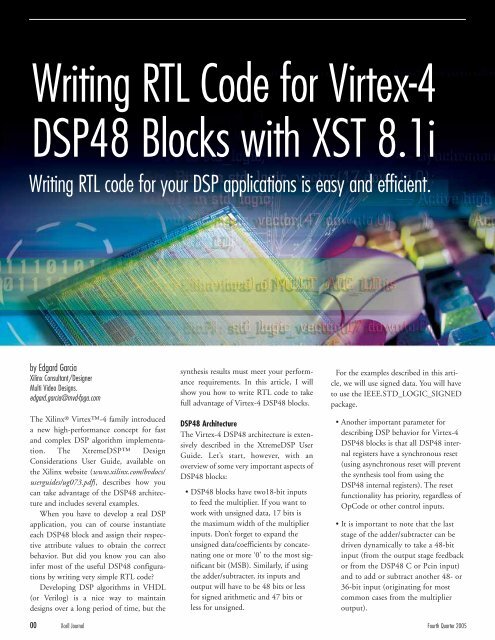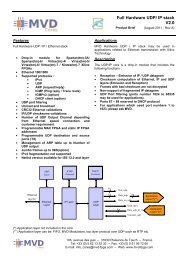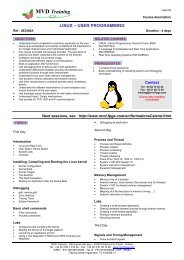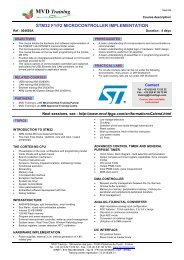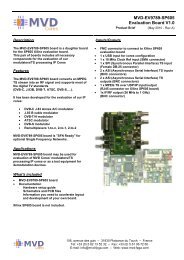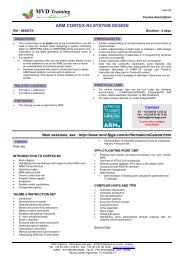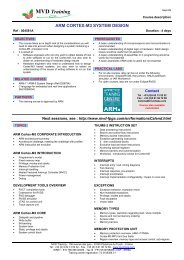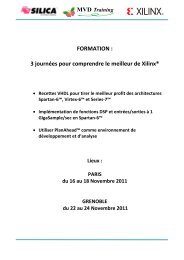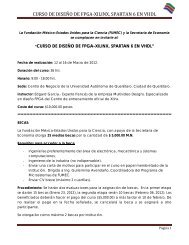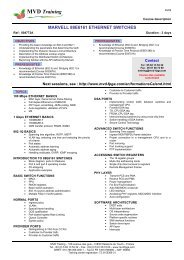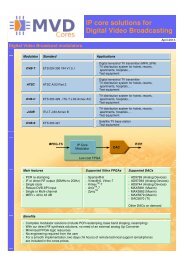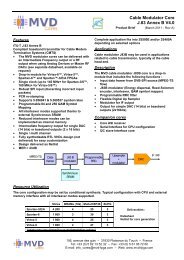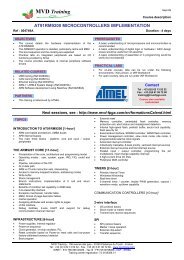Writing RTL Code for Virtex-4 DSP48 Blocks with XST 8.1i
Writing RTL Code for Virtex-4 DSP48 Blocks with XST 8.1i
Writing RTL Code for Virtex-4 DSP48 Blocks with XST 8.1i
Create successful ePaper yourself
Turn your PDF publications into a flip-book with our unique Google optimized e-Paper software.
<strong>Writing</strong> <strong>RTL</strong> <strong>Code</strong> <strong>for</strong> <strong>Virtex</strong>-4<br />
<strong>DSP48</strong> <strong>Blocks</strong> <strong>with</strong> <strong>XST</strong> <strong>8.1i</strong><br />
<strong>Writing</strong> <strong>RTL</strong> code <strong>for</strong> your DSP applications is easy and efficient.<br />
by Edgard Garcia<br />
Xilinx Consultant/Designer<br />
Multi Video Designs.<br />
edgard.garcia@mvd-fpga.com<br />
The Xilinx ® <strong>Virtex</strong>-4 family introduced<br />
a new high-per<strong>for</strong>mance concept <strong>for</strong> fast<br />
and complex DSP algorithm implementation.<br />
The XtremeDSP Design<br />
Considerations User Guide, available on<br />
the Xilinx website (www.xilinx.com/bvdocs/<br />
userguides/ug073.pdf), describes how you<br />
can take advantage of the <strong>DSP48</strong> architecture<br />
and includes several examples.<br />
When you have to develop a real DSP<br />
application, you can of course instantiate<br />
each <strong>DSP48</strong> block and assign their respective<br />
attribute values to obtain the correct<br />
behavior. But did you know you can also<br />
infer most of the useful <strong>DSP48</strong> configurations<br />
by writing very simple <strong>RTL</strong> code<br />
Developing DSP algorithms in VHDL<br />
(or Verilog) is a nice way to maintain<br />
designs over a long period of time, but the<br />
synthesis results must meet your per<strong>for</strong>mance<br />
requirements. In this article, I will<br />
show you how to write <strong>RTL</strong> code to take<br />
full advantage of <strong>Virtex</strong>-4 <strong>DSP48</strong> blocks.<br />
<strong>DSP48</strong> Architecture<br />
The <strong>Virtex</strong>-4 <strong>DSP48</strong> architecture is extensively<br />
described in the XtremeDSP User<br />
Guide. Let’s start, however, <strong>with</strong> an<br />
overview of some very important aspects of<br />
<strong>DSP48</strong> blocks:<br />
• <strong>DSP48</strong> blocks have two18-bit inputs<br />
to feed the multiplier. If you want to<br />
work <strong>with</strong> unsigned data, 17 bits is<br />
the maximum width of the multiplier<br />
inputs. Don’t <strong>for</strong>get to expand the<br />
unsigned data/coefficients by concatenating<br />
one or more ‘0’ to the most significant<br />
bit (MSB). Similarly, if using<br />
the adder/subtracter, its inputs and<br />
output will have to be 48 bits or less<br />
<strong>for</strong> signed arithmetic and 47 bits or<br />
less <strong>for</strong> unsigned.<br />
For the examples described in this article,<br />
we will use signed data. You will have<br />
to use the IEEE.STD_LOGIC_SIGNED<br />
package.<br />
• Another important parameter <strong>for</strong><br />
describing DSP behavior <strong>for</strong> <strong>Virtex</strong>-4<br />
<strong>DSP48</strong> blocks is that all <strong>DSP48</strong> internal<br />
registers have a synchronous reset<br />
(using asynchronous reset will prevent<br />
the synthesis tool from using the<br />
<strong>DSP48</strong> internal registers). The reset<br />
functionality has priority, regardless of<br />
Op<strong>Code</strong> or other control inputs.<br />
• It is important to note that the last<br />
stage of the adder/subtracter can be<br />
driven dynamically to take a 48-bit<br />
input (from the output stage feedback<br />
or from the <strong>DSP48</strong> C or Pcin input)<br />
and to add or subtract another 48- or<br />
36-bit input (originating <strong>for</strong> most<br />
common cases from the multiplier<br />
output).<br />
00 Xcell Journal Fourth Quarter 2005
Basic Examples<br />
1. Multiplier_accumulator. This commonly used function is our<br />
first example, useful <strong>for</strong> FIR filters and other DSP functions. Here<br />
is the source code:<br />
library IEEE;<br />
use IEEE.STD_LOGIC_1164.ALL;<br />
use IEEE.STD_LOGIC_SIGNED.ALL;<br />
— Signed arithmetic is used<br />
entity MULT_ACC is<br />
Port ( CK : in std_logic;<br />
RST : in std_logic;<br />
— Synchronous reset<br />
Ain, Bin : in std_logic_vector(17 downto 0); — A and B inputs of the multiplier<br />
S : out std_logic_vector(47 downto 0) ); — Accumulator output<br />
end MULT_ACC;<br />
architecture Behavioral of MULT_ACC is<br />
signal ACC : std_logic_vector(47 downto 0);<br />
begin<br />
— Accumulator output<br />
process(CK) begin<br />
if CK’event and CK = ‘1’ then<br />
if RST = ‘1’ then ACC ‘0’);<br />
else<br />
ACC
4. Multiplier_accumulator_or_adder. This is another useful version<br />
of the multiplier accumulator. It is useful <strong>for</strong> multiplications of<br />
data buses of more than 18 bits (see Figure 1-18 in the XtremeDSP<br />
User Guide). Here is the <strong>RTL</strong> code:<br />
library IEEE;<br />
use IEEE.STD_LOGIC_1164.ALL;<br />
use IEEE.STD_LOGIC_SIGNED.ALL;<br />
— Signed arithmetic is used<br />
entity MULT_ACC_ADD is<br />
Port ( CK : in std_logic;<br />
RST : in std_logic;<br />
SEL : in std_logic;<br />
A_in, B_in : in std_logic_vector(17 downto 0);<br />
C_in : in std_logic_vector(47 downto 0);<br />
S : out std_logic_vector(47 downto 0));<br />
end MULT_ACC_ADD;<br />
architecture Behavioral of MULT_ACC_ADD is<br />
constant ZERO : std_logic_vector(47 downto 0) := (others => ‘0’);<br />
signal AR, BR : std_logic_vector(17 downto 0);<br />
signal MULT : std_logic_vector(35 downto 0);<br />
signal Pout : std_logic_vector(47 downto 0);<br />
begin<br />
process(CK) begin<br />
if CK’event and CK = ‘1’ then<br />
if RST = ‘1’ then AR ‘0’);<br />
BR ‘0’);<br />
MULT ‘0’);<br />
Pout ‘0’);<br />
else<br />
AR
ture, it is important to write the code in a simple way, giving your<br />
tools the best option to pack your desired functions into each <strong>DSP48</strong><br />
block. For this reason, each code has been written in a single process.<br />
The more simple and compact your <strong>RTL</strong> code, the more efficient<br />
the synthesis result. Of course, depending on your synthesis<br />
tool, other alternatives can also give you excellent results, but they<br />
will be more dependent on the synthesis tools.<br />
Higher Complexity Designs<br />
What happens when you need more complex DSP functions You<br />
can use a similar approach <strong>for</strong> many complex DSP algorithm implementations<br />
by describing each block separately to ensure optimal<br />
synthesis results.<br />
You will find many other examples, most of them directly related<br />
to those explained in their algorithmic and schematic <strong>for</strong>m, in<br />
the XtremeDSP User Guide.<br />
Conclusion<br />
This article is excerpted from the application note, “<strong>Virtex</strong>-4 <strong>DSP48</strong><br />
Inference,” which is available at www.mvd-fpga.com/en/publi_<br />
V4_<strong>DSP48</strong>.html.<br />
The application note includes additional examples, such as:<br />
• Single DSP slice 35 x 18 multiplier (Figure 1-18 in the<br />
XtremeDSP User Guide)<br />
• Single DSP slice 35 x 35 multiplier (Figure 1-19 in the<br />
XtremeDSP User Guide)<br />
• Fully pipelined complex 18 x 18 multiplier (Figure 1-22<br />
in the XtremeDSP User Guide)<br />
• High-speed FIR filter (Figure 1-17 in the XtremeDSP<br />
User Guide)<br />
The application note also describes many of the important features<br />
of <strong>DSP48</strong> blocks supported by <strong>XST</strong> <strong>8.1i</strong> and Synplify-Pro 8.2. MAP<br />
reports, Timing Analyzer reports, and a detailed view of the FPGA<br />
Editor show the efficiency of the synthesis and implementation tools.<br />
You can also see how the cascade chain between adjacent <strong>DSP48</strong> slices<br />
is used to improve both per<strong>for</strong>mance and power consumption. Almost<br />
all of these widely used configurations provide the best implementation<br />
results – in terms of resources used as well as per<strong>for</strong>mance.<br />
However, some remaining limitations are also described. We expect<br />
these few points to be resolved in future releases.<br />
For more in<strong>for</strong>mation, see the XtremeDSP Design<br />
Considerations User Guide at www.xilinx.com/bvdocs/userguides/<br />
ug073.pdf. The methodology is clearly explained and implementation<br />
results analyzed in detail, <strong>with</strong> ISE software tools like<br />
Timing Analyzer and FPGA Editor.<br />
Multi Video Designs (MVD) is a training and design center specializing<br />
in FPGA designs, PowerPC processors, RTOS <strong>for</strong> embedded/real-time<br />
applications, and high-speed buses like PCI Express<br />
and RapidIO. MVD as an Approved Training Partner and a member<br />
of the Xilinx XPERTS program, <strong>with</strong> offices in France, Spain,<br />
and South America.<br />
<strong>XST</strong> Support <strong>for</strong> <strong>DSP48</strong> Inference<br />
<strong>XST</strong>, the synthesis engine included <strong>with</strong> the Xilinx ®<br />
ISE toolset, contains extensive support <strong>for</strong> inference of<br />
<strong>DSP48</strong> macros. A number of macro functions are recognized<br />
and mapped to these dedicated resources, including<br />
adders, subtracters, multipliers, and accumulators, as well as<br />
combinations like multiply-add and multiply-accumulate<br />
(MAC). Register stages can be absorbed into the <strong>DSP48</strong><br />
blocks, and direct connect resources are used to cascade<br />
large or multiple functions.<br />
Macro implementation on <strong>DSP48</strong> blocks is controlled<br />
by the USE_<strong>DSP48</strong> constraint <strong>with</strong> a default value of<br />
auto. In auto mode, <strong>XST</strong> attempts to implement all a<strong>for</strong>ementioned<br />
macros except adders or subtracters on <strong>DSP48</strong><br />
resources. To push adders or subtracters into a <strong>DSP48</strong>, set<br />
the USE_<strong>DSP48</strong> constraint value to yes.<br />
<strong>XST</strong> per<strong>for</strong>ms automatic resource control in auto mode<br />
<strong>for</strong> all macros except adders and subtracters. In this mode<br />
you can control the number of available <strong>DSP48</strong> resources<br />
<strong>for</strong> synthesis using the DSP_UTILIZATION_RATIO<br />
constraint, specifying either a percentage or absolute number.<br />
By default, <strong>XST</strong> tries to utilize, as much as possible, all<br />
available <strong>DSP48</strong> resources <strong>with</strong>in a given device.<br />
With the <strong>8.1i</strong> release of ISE software, <strong>XST</strong> has introduced<br />
further enhancements to its DSP support. <strong>XST</strong> can<br />
now infer loadable accumulators and MACs, which are<br />
critical <strong>for</strong> filter applications. <strong>XST</strong> can recognize chains of<br />
complex filters or multipliers – even across hierarchical<br />
boundaries – and will use dedicated fast connections to<br />
build these <strong>DSP48</strong> chains. The Register Balancing optimization<br />
feature will consider the registers <strong>with</strong> <strong>DSP48</strong><br />
blocks when optimizing clock frequencies. Consult the<br />
<strong>XST</strong> User Guide (http://toolbox.xilinx.com/docsan/xilinx7/<br />
books/docs/xst/xst.pdf) <strong>for</strong> details about coding styles, and<br />
watch the synthesis reports <strong>for</strong> specific implementation<br />
results <strong>for</strong> your <strong>Virtex</strong>-4 designs.<br />
– David Dye<br />
Senior Technical Marketing Engineer<br />
Xilinx, Inc.<br />
Fourth Quarter 2005 Xcell Journal 00


